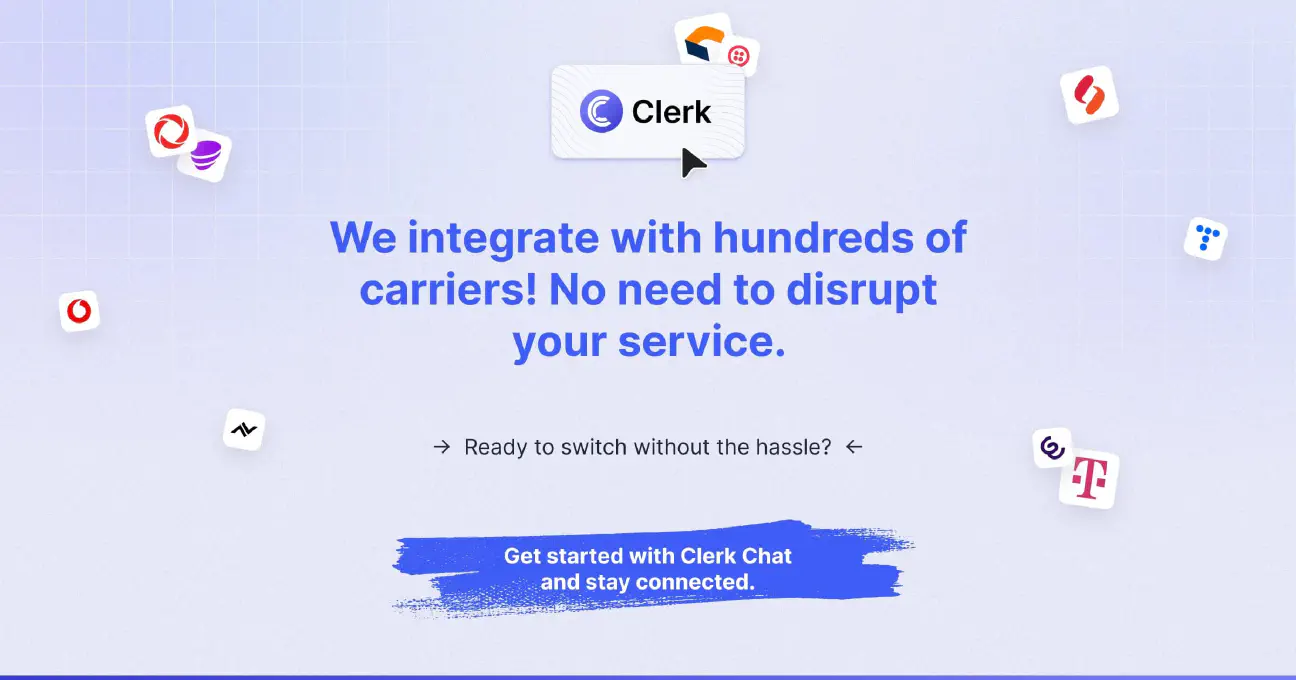How to Switch Cell Phone Carriers and Keep Your Business Number
By Igor Boshoer
- Published: January 16, 2025
Wondering how to switch cell phone carriers? We get it. Sometimes, transitioning to a new carrier is the best way to reduce your phone bills, access new perks and benefits, or simply upgrade to a higher-quality phone and a better overall plan.
The good news? Switching to a new phone carrier is a lot easier than it used to be. In the past, if you wanted to make a change you’d have to call a customer service team and spend forever just waiting for your new phone to arrive or your number to be ported onto a different device.
These days, switching to a new carrier, whether you’re an everyday consumer or a business leveraging bulk SMS services, is pretty straightforward.
This step-by-step guide will tell you everything you need to know.
In this article:
When Should You Switch Phone Carriers?
Before we cover “how” to change cell phone carriers, it’s worth thinking about when it makes the most sense to alter your provider.
If you’re happy with the customer service, support, and overall performance of your current carrier, but you just want a new phone or a lower bill, you might not need to switch carriers. Instead, you could simply contact your carrier and ask for their advice on how to switch phone plans to something that better suits your current needs.
On the other hand, switching to a new carrier might make sense if you:
- Need access to new features: For instance, if you’re a business leader investing in SMS marketing or text-based customer service, you might need a carrier that supports a wider range of VoIP and non-VoIP numbers or better global geographic coverage.
- Want better customer service: If your carrier is constantly experiencing outages or never responds promptly to support requests, switching to another provider might give you a more consistently reliable experience.
- Need to cut costs: Switching to another carrier could help you to access better rates for calls and messaging services. This could be particularly important if you’re regularly sending comprehensive SMS campaigns to a lot of different contacts.
Frustrated with your current carrier's 10DLC process? Make the switch and experience lightning-fast registration and reliable messaging.
10DLC registration approval
Migrate your existing numbers
Minimal downtime
Reliable deliverability
When Not to Switch Phone Carriers
As mentioned above, there’s no need to learn how to change phone carriers if you can get a better deal and a new phone with all the features you need from your existing provider. You also shouldn’t have to switch carriers to take advantage of cutting-edge SMS platforms like Clerk Chat, as they often support “bring your own carrier” options, and can enable access to a wide range of features.
One time you definitely shouldn’t switch phone carriers is when you’re tied into a long-term contract and will have to pay high termination fees to move to another provider.
It’s also worth remembering that you should never cancel your current phone plan before you switch if you want to keep your existing number (more on that later).
What to Consider Before You Switch Phone Carriers
We’ll show you how to switch cell phone carriers in just a minute, but before you make the transition, there are a few key things to consider:
Costs and Potential Fees
As mentioned above, switching phone carriers can be a great way to save money. However, it’s important to think about the overall cost of switching to a new provider, too. Some key costs to keep in mind include:
- Termination fees: These days, most major carriers have eliminated the standard “two-year contract” for consumers. But if you’re using your carrier for A2P messaging or business strategies, there may be a hefty fee for ending your contract early. Make sure you check your contract before you start the transition.
- Device fees: Unless you purchased your phone outright, the monthly fees you pay to your carrier may include the cost of “paying off” a new device. Double-check that there aren’t any outstanding balances left to pay on your phone before you switch carriers. You also want to find out if you’ll have to pay anything upfront for a new device.
- Setup Costs: If you’re switching to a new carrier as a business and you need a new number with a new plan and device, there may be extra costs to consider. Think about the fees of 10DLC registration and how much you’ll need to pay for business messaging platforms.


Phone and Number Compatibility
If you plan on continuing to use your current cell phone, you’ll need to make sure that phone is compatible with the new provider’s network. Some phones are “locked” to a specific carrier, while others are “unlocked” or can be unlocked for a fee.
If your phone can’t be unlocked, you’ll need to factor in the cost of paying for a new device when switching providers. Make sure you keep an eye out for special deals in this case, as some carriers offer access to the latest phones as part of their plans to attract new customers.
It’s also worth double checking if you can actually port your existing number to a new carrier’s network. This is particularly important for companies that want to maintain existing 10DLC numbers, or specific fixed and non-fixed VoIP numbers when moving carriers.
Other Considerations
Other key points to keep in mind before you learn how to switch cell phone carriers include:
- Coverage options: Make sure your carrier delivers reliable coverage in the locations that matter most to you. If you’re looking for global connectivity, check out any international roaming plans and fees that might apply for international communications.
- Data speeds and limitations: Consider the data speeds offered by your new carrier – particularly if you use a lot of data-intensive applications, like WhatsApp, or streaming applications. Find out what happens if you exceed your data limits.
- Customer service: Learn as much as you can about your carrier’s approach to customer service. How easy do they make it to access new numbers or port your existing phone number from an external provider? How quickly do they respond to service requests?
Another point to consider is how switching to a new carrier might affect your credit score. Some carriers conduct “hard checks” to ensure you can actually pay for your new contract. This can temporarily harm your credit rating – but shouldn’t have a long-term impact on your score.
How to Switch Cell Phone Carriers Successfully
Actually switching cell phone carriers is usually a lot simpler than you’d think. All you need to do is gather the right information, do a little prep work, choose the right carrier and initiate the switch. Here’s your step by step guide to navigating the process.
Frustrated with your current carrier's 10DLC process? Make the switch and experience lightning-fast registration and reliable messaging.
10DLC registration approval
Migrate your existing numbers
Minimal downtime
Reliable deliverability
Step 1: Check Your Current Contract
First, review your current carrier contract to make sure there aren’t any early termination fees, penalties, or additional costs to worry about. Make sure the phone included with your plan is paid off, and remind yourself of all the perks and benefits included on your current plan.
For instance, double-checking how much you currently pay for things like SMS messages, phone calls (locally and internationally), and data can help you when it comes to comparing new carriers.
Step 2: Decide What you Want to Keep
Just because you decide to switch to a new phone carrier, doesn’t mean you have to change everything. You can usually choose to retain the same number – which is ideal if you’re already using a specific number for your business messaging strategies.
Maintaining the same number can make it easier for existing customers to recognize you when you get in touch and reconnect with your team. It can also help with SMS compliance, particularly if you’re using a specific type of number for B2C or B2B SMS marketing.
If you do decide to change your number, make sure you have a strategy in place for sharing your new number with all clients and contacts. You may also need to get “consent” from your customers to contact them again using your new number.
Alongside your number, you can also choose to keep your phone – provided that your phone and SIM card are compatible with the carrier you’ve chosen.
Step 3: Back Up your Data
These days, most smartphones can easily transfer information (such as contact details, applications, and even photos from one phone to another). However, it’s worth backing everything up just in case. That’s particularly true if you need to save a lot of contact details, because you’re using your phone for promotional SMS campaigns or customer service.
You can back your phone up with a cloud service or consider using a specific platform like Clerk Chat to create a central copy of all your contact details, transactional SMS templates, and other data.

Step 4: Gather Business Information
While figuring out how to change phone carriers is easier than it once was, you’ll still need to share some specific information with your new provider. If you’re wondering “what do you need to transfer phone carriers” it might help to contact the carrier directly and ask. Most of the time, however, your new provider will ask for your name and address, as well as:
- The password or PIN you use with your current carrier
- Your phone’s ESN or IMEI number (for number porting)
- The account number of your current plan
Step 5: Compare Carriers and Plans
This is probably the trickiest part of learning how to switch cell phone carriers. Ultimately, there are dozens of great carriers out there that offer access to similar coverage, deals, and devices. You can explore options ranging from AT&T and Verizon to T-Mobile, and even newer, niche carriers.
The most important thing to focus on when comparing your options, is coverage in your chosen area. For instance, in rural locations, some carriers offer less coverage than others. Other points to consider, aside from data speed options, international roaming features, and phone compatibility include:
- Unique perks: Look for carriers offering access to unique perks and deals, such as cheaper texting rates when you’re using your phone to send mass messages, access to unlimited data, or ultra-fast 5G connectivity.
- Devices and features: If you’re going to be accessing a new device with your new plan, look at the options your carrier can offer. Some carriers have better partnerships with specific vendors which can save you money on the price of a new handset.
- Special deals: Many carriers offer additional savings and deals for specific groups of consumers, such as people in the military, students, and teachers. Ask about eligibility requirements for these deals before you switch.
Frustrated with your current carrier's 10DLC process? Make the switch and experience lightning-fast registration and reliable messaging.
10DLC registration approval
Migrate your existing numbers
Minimal downtime
Reliable deliverability
Step 6: Port Your Number
If you’ve decided to keep your existing number for A2P 10DLC SMS communications, SMS marketing, or compliance purposes, porting your number is a crucial next step. Most carriers should make this process pretty simple – but remember, you do need to keep your current plan with your previous provider “active” until the porting process is complete.
Once you’re ready to transfer your number, contact your new carrier, and make sure you have all of the information mentioned above ready (your name, address, phone number, and IMEI/ESN number). Ask to initiate the porting process, and your new carrier will contact your old provider to handle the transition for you.
Once your number has been “activated” with your new provider, the service you had with your old provider should be cancelled automatically. Keep in mind, the transition can take a couple of days, so if you’re using your number for conversational messaging, customer service, or other business tasks, make sure you’re prepared for possible disruption.
You might want to consider scheduling SMS messages in advance to inform customers about the temporary disruption in your service or temporarily using an alternative number.
Step 7: Finish the Switch
Once your number is ported and your new device and plan are set up, you’re done! You might receive a final bill from your old carrier, but you should be able to start using your new carrier as normal for everything from standard SMS messaging and calling to text-based marketing campaigns.
If you are going to be using your plan with a new carrier for business communications, make sure you familiarize yourself with compliance guidelines (like TCPA compliance rules), and check with your business messaging platform provider whether “bring your own carrier” options are available.
Leading platform providers, like Clerk Chat, should make it easy to use any carrier you choose with your messaging service. With our platform, you can even text from a landline!
Still Wondering How to Change Phone Carriers?
There you have it, everything you need to know about switching cell phone carriers, whether you’re an everyday consumer looking for a better deal, or a business in search of better coverage and higher deliverability rates.
Need help making the most of your new plan? Contact Clerk Chat to learn how our platform can help you unlock the benefits of business messaging, access state-of-the-art AI tools, and automate endless marketing, sales, and customer service tasks.
An innovator by nature, Igor is dedicated to translating the technical aspects of product development into actionable business strategies and sales growth. He thrives when building scalable infrastructures while leading global teams to success. In his free time he indulges in his passions for film, mathematics, and engineering. Find his tech expertise in films like The Wolf of Wall Street.
In this article:
Ready to use your business number for text messaging?
Thousands of businesses are already experiencing the power of conversational messaging through SMS. Join us. Free trial and paid tiers available.
Get Started#Subscribe
Get product updates in your inbox
Tutorials, features, and Clerk Chat news delivered straight to you.




